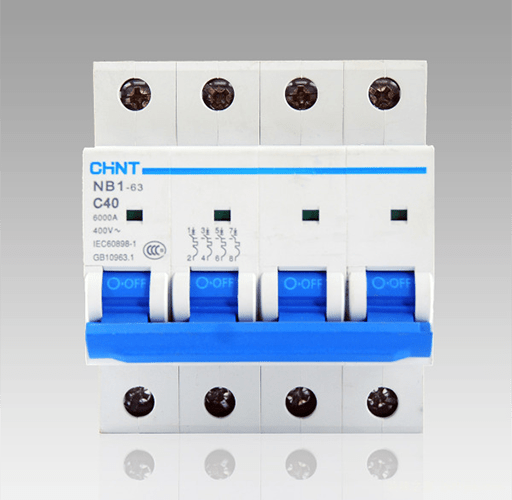
Figure 1: Circuit breaker.
Circuit breakers are an essential part of any electrical system. Circuit breakers protect homes from various electrical hazards (such as overloading) and cut off power if the current becomes unsafe. Circuit breakers are widely used in daily life, but many of us do not understand how circuit breakers work. Have you ever wondered how circuit breakers work for electrical protection?
1. What is a Circuit Breaker
A circuit breaker is an electrical switch that can close, carry and break current under normal circuit conditions and can close, carry and break current under abnormal circuit conditions within a specified time.
The circuit breaker has a handle or lever that allows you to manually turn the circuit breaker on or off. A circuit breaker cannot close automatically, but it can open itself under the conditions that short circuit and overload occur.
2. How Circuit Breakers work

Figure 2: Internal structure of circuit breaker.
A circuit breaker interrupts the flow of current when the current exceeds a predetermined amount. It is where the rating of the circuit breaker comes into play. Based on the rating of the circuit breakers, they can safely carry the amount of current, or can safely interrupt the flow of electricity.
2.1 Basic Design of Circuit Breakers
Frame
The frame is the outer casing of the circuit breaker, usually made of molded insulating material. This protects the components inside the circuit breaker and anything outside in the event of a hazard.
Terminal
The terminal is a piece of metal with a stud on the outside. This connects the wires that carry current from the power source, through the circuit breaker, and to the load.

Figure 3: A damaged circuit breaker.
Lever
A lever (switch) is attached to the trip unit and allows the circuit breaker to be opened or closed. When the breaker trips, the lever will be in the middle to quickly identify the breaker that needs troubleshooting.
Contact
Contacts are two pieces of metal that move to close or open (interrupt) a circuit. One contact is connected to the actuator and the other is connected to the main panel.
Actuator Mechanism
The actuator is the metal arm inside the circuit breaker. One end is connected to the lever and the other end is connected to the contact. When the lever is flipped, the actuator pushes the contacts together or pulls them apart.
Trip Unit
The trip unit is the part that tells the circuit breaker when to trip automatically in the event of an overload, short circuit, or fault.
2.2 Working Principle of Circuit Breaker

Figure 4: Current flowing inside a circuit breaker.
When the lever of the circuit breaker is switched to the "on" position, it allows power to flow freely from the source (usually an electrical panel or mains) through the trip unit, contacts and upper terminals to power the load on a circuit.
When a short circuit occurs, the magnetic field generated by the large current (generally 10 to 12 times) overcomes the reaction force spring, the release pulls the operating mechanism to act, and the switch trips instantaneously.
The bimetal of the thermal magnetic trip unit can overheat under conditions, such as overload, causing it to bend and open (automatic cut-off of power). When overloaded, the current becomes larger, the heat generation increases, and the bimetallic strip deforms to a certain extent to promote the action of the mechanism, thereby causing the switch to trip. The higher the current, the shorter the action time.
3. Conclusion
All parts of the circuit breaker work together to interrupt the current flow when the charge exceeds a safe amount. Circuit breakers are designed to protect our circuits from hazards. Many electrical hazards can be avoided, so be sure to double-check that a circuit isn't loaded too much, looking for any loose connections or outdated hardware in case the circuit breaker fails and doesn't work properly.
Related Info
How to Replace a Circuit Breaker?How Does a Refrigeration Compressor Work? With Animation for Each Type
Analysis and troubleshooting of common faults in cold and hot water air conditioning systems


